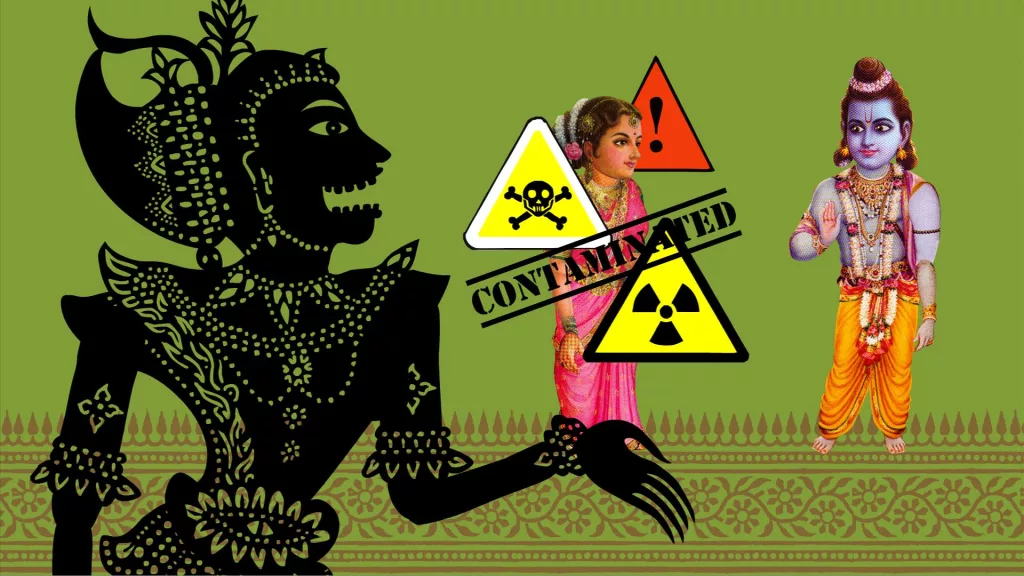United States, 2008
Directed by Nina Paley
(Animated movie)

In a definitely counter-intuitive and baffling way this adaptation of the “Ramayana”, the famous Indian epic and religious poem, starts in San Francisco in the bedroom of an American couple with their cat waking up and right away demanding food before they start their morning their routine, which involves a lot of kissing. David and Nina are clearly a happy couple, deeply fond of each other and satisfied with their quiet life. The characters are drawn in rough and childish lines that wobble, with part of the backdrop made up of a funny collage involving genuine photographs of buildings and streets of Frisco. “Sita Sings the Blues” first looks like a makeshift, spontaneous, zany effort whose connections to the “Ramayana” are really hard to gather, even though the titles appeared over highly stylized images of Hindu divinities floating above the sea.
But the job offer David gets soon to work in the booming information technology industry of India alters the film’s course: it will nevertheless takes the film’s full runtime to grasp what the bond between the modern-day characters and those who allegedly came to life some 3,000 years earlier is. This adaptation’s originality is to make the mythic love story between Rama, who is both a warrior and an avatar of the god Vishnu, and Sita, a frame that both reflects the drama Nina is experiencing – David stays on in India and stops loving her without explanation – and allows for a wider discussion about why a man can stop loving a woman and what is the true meaning of fidelity.
This discussion is expressed by a trio of shadow puppets, delicately cut silhouettes reminding the style this performing art has in Indonesia as well as the faces of Hindu mythic characters, who regularly feature in the course of the quite elaborate narrative, chatting and bantering, fumbling into the details of the poem and at the same time commenting passionately about its characters. The tale is told but also dissected and echoes more and more clearly the sad situation Nina finds herself.
To be honest, this animated movie does not cover the full extent of the “Ramayana”. If the outlines are faultlessly presented, details can be simplified or deliberately omitted. This is not the whole life story of Rama that matters but his love, and then disdain, for Sita. Sita, for her part, gets a bigger voice as the title suggests: it is not just she readily takes center stage and is at length analyzed by the shadow puppets, she sings a lot and turns the film into a musical boldly based on jazz music, with all her singing coming from records made by Annette Hanshaw, a popular entertainer in the 1920s and 1930s United States, famous not just for her skills and her popularity but also for cutting deliberately short her career. Sad songs about break-ups, ill-starred loves, male meanness, offer a fresh, both alluring and cutting, perspective on Sita’s fate. They also add another style of animation as the musical numbers are drawn in a decidedly cartoonish style typical of old American shorts, with Sita taking cannily the unforgettable features of Betty Boop.
Here is the other, striking, originality of “Sita Sings the Blues”: the film is a dazzling and exhilarating mix of various animation techniques and styles of drawings, which come from an audaciously wide range of inspirations, including the early Hindu Sultanate paintings, the more sophisticated Mughal art, the cheap pictures of the current-day Hindu devotion, or the Fleischer Studios’ flicks. It could have been a real mess, and arguably the film tends to go overboard at times, even featuring an intermission that is a comic but unnecessary, wanton tribute to Bollywood. But focused on its theme, it turns out to be a vibrant, jaunty, defiant reading of the “Ramayana” that underlines Sita’s sincerity and tragedy, eventually paying tribute to her and acknowledging her as an inspiration. Indeed, the narrative circles back at the end in San Francisco where Nina has made a fresh start and reads the “Ramayana” for consolation perhaps, or just to enjoy the story and relate to it.
The film, widely available on the Internet, can obviously be slammed as a problematic adaptation to some. But it is actually a really good one, in the sense that adapting means offering a personal reading, sincere but rigorous, of a given text which allow the artists to use their skills as they see it fit – and even to experiment – to invite the audience to have a fresh look at supposedly well-known tales that may be have still even more to tell us than thought. Entertainment is anyway a decent goal, even more if the characters give their audience the precious opportunity to reflect seriously on their lives and beliefs. With her cheerful flow of images, notes, and words, her deep respect for a myth, and her tender appreciation for romance, tinged with sparkling wit and informed by her own labor of love, director Nina Paley delivers a delightful animated movie. And it wows also as a deeply personal work, a one-woman show of skills commanding respect: Paley has written, designed, animated, shot, and produced this genuinely imaginative and exciting film herself.

